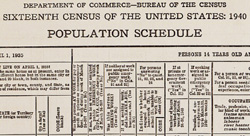
1790 Census Records
The 1790 population census was the First Decennial Census of the United States. Taken every 10 years since 1790, census records provide a snapshot of the nation's population.
Frequently Asked Questions About the 1790 Census
Why was the 1790 Census taken?
Article I, Section 2, of the U.S. Constitution established that representation in the U.S. House of Representatives was based on population determined by a census taken at 10 year intervals: "The actual Enumeration shall be made within three Years after the first Meeting of the Congress of the United States, and within every subsequent Term of ten Years, in such Manner as they [Congress] shall by Law Direct."
What was the official census day?
Monday, August 2, 1790.
When was it taken?
The census began on Monday, August 2, 1790, and was finished within 9 months, under the rules and directions established in an Act of Congress approved March 1, 1790 ( “An Act providing for the enumeration of the Inhabitants of the United States,” 1 Statutes at Large 101).
Who was counted?
The law required "That every person whose usual place of abode shall be in any family on [August 2, 1790], shall be returned as of such family; and the name of every person, who shall be an inhabitant of any district, but without a settled place of residence, shall be inserted in the column of the aforesaid schedule, which is allotted for the heads of families, in that division where he or she shall be on [August 2, 1790], and every person occasionally absent at the time of the enumeration, as belonging to that place in which he usually resides in the United States."
Who was involved?
- President George Washington had general supervision as head of the U.S. Federal Government.
- The U.S. Marshal for each Federal judicial district was responsible for taking the census in his district with the help of assistant marshals whom he appointed. Each took an oath or affirmation that "I will well and truly cause to be made, a just and perfect enumeration and description of all persons resident within my district, and return the same to the President of the United States, agreeably to the directions of an act of Congress, entitled, 'An act providing for the enumeration of the inhabitants of the United States,' according to the best of my ability."
- Every person over age 16 was required to cooperate: "That each and every person more than sixteen years of age, whether heads of families or not ... shall be, and hereby is, obligated to render to such assistant [marshal] ... a true account, if required, to the best of his or her knowledge, of all and every person belonging to such family ... on pain of forfeiting twenty dollars...."
What questions did the census ask?
- Name of head of family
- Number of free white males age 16 years and upwards, including head of family
- Number of free white males under 16 years old
- Number of free white females, including head of family
- Number of all other free persons [free African-Americans]
- Number of slaves
What did the census form look like?
The Federal Government did not provide blank printed forms to the U.S. Marshals. Only in Massachusetts were uniform printed forms used that were supplied by the U.S. Marshal at his own expense to his assistants. In all other states, the assistant marshals used whatever paper was available, so the census returns vary in page length from 4 inches to 3 feet, and some were entered in merchants' account books, journals, or ledgers. Congress required the format shown below for the 1790 census returns:

There are annotations on and attachments to these schedules, such as certificates of oaths taken and population totals for various counties. Later annotations made by clerks in charge of census records include tables of contents and page references to names of prominent persons.
What states are included in the census?
Surviving records include census schedules for Connecticut, Maine, Maryland, Massachusetts, New Hampshire, New York, North Carolina, Pennsylvania, Rhode Island, South Carolina, and Vermont. Special notes:
- Maine was part of Massachusetts in 1790.
- Rhode Island finally ratified the Constitution on May 29, 1790, so Congress passed the Act of Congress of July 5, 1790 (1 Statutes at Large 129) to include that state in the census.
- Vermont became a state on March 4, 1791, so the census was taken in Vermont in 1791 (1 Statutes at Large 197).
- Persons residing in the area that became the District of Columbia are included in either Montgomery or Prince George's counties, Maryland, because the location of the District was not authorized by Congress until July 16, 1790.
Are some 1790 census records missing?
Yes. There are no schedules for Delaware, Georgia, Kentucky, New Jersey, Tennessee, and Virginia. From 1790 to 1820, the original population schedules were to be deposited with the clerks of district courts (or superior courts in the territories), "who were to receive and carefully preserve the same." On May 28, 1830, a Congressional resolution (4 Statutes at Large 430), directed the clerks of the district courts to forward the population schedules for the first four censuses to the Secretary of State. It is known that the 1790 schedules for Rhode Island were forwarded to Washington on June 22, 1830, as a result of the May 28 resolution. Presumably other extant population schedules, 1790-1820, were forwarded at about the same time, but no documentation of such action has been found. It is possible that individual census pages for other locations were lost between 1830 and when they were bound in volumes in the early 1900s.
Where can I see the original 1790 census schedules?
Digital images of National Archives Microfilm Publication M637, First Census of the United States, 1790 (12 rolls), can be seen on popular genealogy websites, including Ancestry.com, FamilySearch.org, and others.
Has the 1790 census been published in books?
Yes, in 1907-1908, the Bureau of the Census published a series of volumes entitled Heads of Families at the First Census of the United States Taken in the Year 1790. Digital images are available online in the National Archives Catalog and at the following links:
- Heads of Families at the First Census of the United States Taken in the Year 1790: Connecticut (Washington: Government Printing Office, 1908).
- Heads of Families at the First Census of the United States Taken in the Year 1790: Maine (Washington: Government Printing Office, 1908).
- Heads of Families at the First Census of the United States Taken in the Year 1790: Maryland (Washington: Government Printing Office, 1908).
- Heads of Families at the First Census of the United States Taken in the Year 1790: Massachusetts (Washington: Government Printing Office, 1908).
- Heads of Families at the First Census of the United States Taken in the Year 1790: New Hampshire (Washington: Government Printing Office, 1907).
- Heads of Families at the First Census of the United States Taken in the Year 1790: New York (Washington: Government Printing Office, 1908).
- Heads of Families at the First Census of the United States Taken in the Year 1790: North Carolina (Washington: Government Printing Office, 1908)
- Heads of Families at the First Census of the United States Taken in the Year 1790: Pennsylvania (Washington: Government Printing Office, 1908).
- Heads of Families at the First Census of the United States Taken in the Year 1790: Rhode Island (Washington: Government Printing Office, 1908).
- Heads of Families at the First Census of the United States Taken in the Year 1790: South Carolina (Washington: Government Printing Office, 1908).
- Heads of Families at the First Census of the United States Taken in the Year 1790: Vermont (Washington: Government Printing Office, 1907).
- Heads of Families at the First Census of the United States Taken in the Year 1790: Virginia (Records of the State Enumerations: 1782 to 1785) (Washington: Government Printing Office, 1908). Due to the loss of the 1790 census for Virginia, the Bureau of the Census compiled a partial "census" based on records held by the Library of Virginia that consisted of state enumerations made in 1782-1785 and Greenbrier County tax lists for 1783-1786. Read the introduction to this volume for further details.


